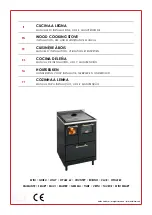
18
manufactured in accordance with BS 8423:2010 + A1: 2016
must be used
and such persons
must
be
supervised at all times.
It is also recommended that all other people should use a fireguard in accordance with BS
8423:2010 + A1: 2016
at all times
when the stove is alight or hot.
3.4 The chimney.
Refer to current National laws, Building Regulations, and any Rules in Force, including British
standard BS EN 15287-1:2007 and BS 8303 and (Approved Document J England & Wales)
The construction of the masonry chimneys, flue block chimneys and connecting flue pipe system
must meet the requirements of the
Current National laws, Building Regulations, and any Rules in
Force.
This stove must
never
be connected to any shared chimney.
An efficient modern stove places heavy demands on the chimney, and you should have the
chimney regularly swept and inspected at least twice a year for smokeless fuel use and quarterly
for wood fuel use by an approved chimney sweep.
The flue or chimney system
must be
in good condition. It must be inspected and swept by a
competent registered person and passed for use with the appliance before installation. The
National Association of Chimney sweeps (NACS) and for Northern Ireland (NIACS) Northern
Ireland Association of Chimney Sweeps offer a register of approved chimney sweeping and
inspection services who will issue certificates after inspection and sweeping.
Where the chimney is believed to have previously served an open fire installation it is possible that
the higher flue gas temperatures from a closed appliance may loosen deposits that were previously
firmly adhered, with the consequent risk of flue blockage. It is therefore recommended that the
chimney be swept a second time within a month of regular use after installation by an approved &
competent chimney sweep.
If it is necessary to fit a register plate it
must
conform to the
Current National laws, Building
Regulations, and any Rules in Force.
The minimum height of the flue or chimney must be 4.5m from the hearth to the top of the flue,
with no horizontal sections and a maximum of 4 bends. Bends must have angles of less than 45
degrees from the vertical. There should be at least 600mm of vertical flue pipe above the appliance
before any bends are introduced. Ensure the connecting flue pipe is kept a suitable distance from
any combustible material and does not form part of the supporting structure of the building.
The installer
must ensure
the flue pipe diameter is not less than the diameter of the outlet of the
appliance and does not narrow to less than the size of the outlet at any point in the system.
Make provision to remove the appliance without the need to dismantle the chimney.
Any existing flue
must be
confirmed as suitable for the new intended use as defined in the Current
Building Regulations.
The flue or chimney systems
must be
inspected and swept by an approved chimney sweep to
confirm the system is structurally sound and free from obstructions.
The flue exit from the building
must comply
with
Current National laws, local building control
rules, Building regulations and any Rules in Force.
Chimney heights and / or separations may need to be increased in particular cases where wind
exposure, surrounding tall buildings, high trees or high ground could have adverse effects on flue
draught
It is
highly recommended
that an approved and certified flexible flue liner that complies with
Current National laws, Building Regulations and any Rules in Force
of the correct internal
Summary of Contents for Windermere 5 SE
Page 9: ...9 Fig 1 1 Main grate positioning Fig 1 2 Top steel baffle positioning...
Page 12: ...12 Fig 1 6 Banking bar positioning Fig 1 7 Ash pan positioning...
Page 52: ...52 4 9 Part Identification Windermere 5 SE...
Page 54: ...54 5 0 Declaration of Performance Energy label Product Fiche 5 1 Declaration of Performance...
Page 55: ...55 5 2 Energy Label...
















































